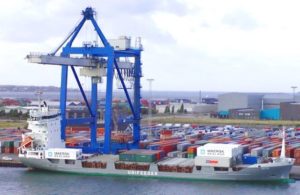 Players in the air cargo and sea freight industry continue to evince increasing signs of unease about growth prospects, as indicated by the latest Stifel Logistics Confidence Index, which edged down slightly as it remained in the negative for July.
Players in the air cargo and sea freight industry continue to evince increasing signs of unease about growth prospects, as indicated by the latest Stifel Logistics Confidence Index, which edged down slightly as it remained in the negative for July.
Their apprehensions were not comforted by trends in air and sea freight transport, as IATA forecasts a “disappointing” year for air cargo, and container shipping rates have hit new lows, said the new index results released by Transport Intelligence (Ti), a research consultant for the global logistics industry.
IATA data showed that global air cargo traffic grew by a mere 0.9% in May 2016, with European growth counterbalancing declines in Asia and North America. Yields were weakened once more, as capacity grew by 4.9% compared to the previous year.
In containerized sea freight, meanwhile, rates appeared to be bottoming out. According to Drewry, the price of transporting a forty-foot container unit from Asia to the U.S. West Coast has hit $800, while the chief commercial officer of Maersk subsidiary MCC Transport has observed intra-Asia freight rate declines of as much as 30%.
Meanwhile, the Panama Canal has reopened to traffic, allowing the transit of so-called “Neo-Panamax” vessels of up to 14,000 TEUs in size. The implications of this are greater competition between East and West Coast ports in the U.S., though many of the former are not yet ready for the larger ships, said Ti.
Alliance activity continues in the industry, with Hyundai Merchant Marine joining the 2M Alliance, with suggestions that it will be joined by Israeli carrier Zim. Nonetheless, actions to reduce capacity are now at the forefront of many minds.
In the air freight sector, following a period of upward momentum, the index declined for the second month in a row, falling by 0.8 points month-on-month, and by 8.4 points year-on-year. It is 4.8 points below the result for July 2014.
For the present situation, air freight results fell by 0.7 points to 45.5. Except for the Europe-Asia lane, which gained 2.1 points to 43.9, the rest recorded month-on-month declines: Asia to Europe lost 2.5 points to 45.9, while Europe-U.S. and U.S.-Europe lost 1.3 and 1.5 points, to 47.2 and 45.1, respectively, said the Ti report.
On expectations regarding air freight growth, the index fell by 0.8 points to 53.7, with declines across the board. The greatest of these was Europe-Asia, which fell by 1.6 points to 51.5. Meanwhile, Europe-U.S. lost 0.6 points to 51.9. As for Asia-Europe and U.S.-Europe, they each lost 0.5 points, falling to 55.5 and 55.9 points, respectively.
For sea freight, the logistics confidence index in July improved by 0.3 points to 47.9, chiefly drawn from the expected situation index, though the present index also rose slightly.
Standing at 42.3, the present sea freight index remained negative, as were all four individual lanes surveyed. Only one lane, Europe-Asia, registered an improvement for the month, increasing by 3.8 points to 38.4. Of the remaining lanes, U.S. to Europe declined by 1.8 points to 38.2, representing the lowest scoring lane surveyed. Asia-Europe declined 1.2 points to 45.1, while Europe to U.S. fell 0.6 points to 47.5.
The sea freight expected index rose at a slightly greater rate of 0.5 points to 53.4, though the picture among the lanes was mixed. Europe to U.S. rose by 1.9 points to 55.1, and Europe to Asia gained 1.5 points to 50.1. In contrast, U.S. to Europe lost 1.5 points to total 50.8, and Asia to Europe contracted by 0.1 points to 57.2.
Photo: Stan Shebs





